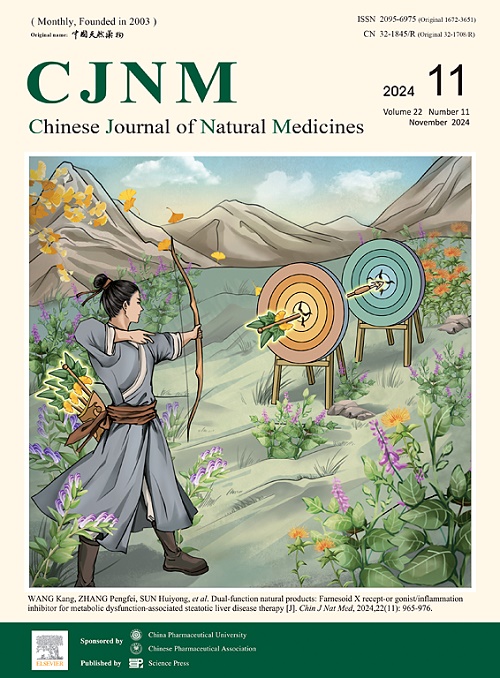天然药物可在畜牧业中替代抗生素:花梨木精油对沙门氏菌感染的保护作用和机制
IF 4
2区 医学
Q1 INTEGRATIVE & COMPLEMENTARY MEDICINE
引用次数: 0
摘要
Aniba rosaeodora 精油(RO)具有显著的抗抑郁和抗菌特性,传统上一直被天然药物用作抗生素的替代品。沙门氏菌是食源性疾病中的一种常见病原体,对目前的抗生素治疗方法构成了巨大挑战。然而,RO 对沙门氏菌的抗菌效果和作用机制仍未得到充分探索。本研究旨在阐明 RO 的化学成分,评估其在体外对沙门氏菌的抗菌活性和作用机制,并进一步阐明其在沙门氏菌感染过程中的体内抗炎机制。气相色谱-质谱法(GC-MS)被用来表征 RO 的化学成分。使用最小抑菌浓度(MIC)和时间致死试验评估了 RO 的抗菌活性。还采用了各种生化试验来揭示潜在的杀菌机制。此外,还建立了小鼠和小鸡沙门氏菌感染模型,以研究 RO 治疗的预防效果。RO 对革兰氏阳性菌和革兰氏阴性菌都有明显的抗菌活性,对沙门氏菌的 MIC 为 4 mg-mL-1。此外,RO 还能减少受感染小鼠和雏鸡的损伤和微生物定植。RO 处理还通过抑制促炎途径调节宿主炎症反应。总之,我们的研究结果表明 RO 能有效抑制沙门氏菌感染,突出了其作为抗生素替代品进行抗菌治疗的潜力。本文章由计算机程序翻译,如有差异,请以英文原文为准。
Natural medicine can substitute antibiotics in animal husbandry: protective effects and mechanisms of rosewood essential oil against Salmonella infection
Aniba rosaeodora essential oil (RO) has been traditionally used in natural medicine as a substitute for antibiotics due to its notable antidepressant and antibacterial properties. Salmonella, a prevalent pathogen in foodborne illnesses, presents a major challenge to current antibiotic treatments. However, the antibacterial efficacy and mechanisms of action of RO against Salmonella spp. remain underexplored. This study aims to elucidate the chemical composition of RO, evaluate its antibacterial activity and mechanisms against Salmonella in vitro, and further delineate its anti-inflammatory mechanisms in vivo during Salmonella infection. Gas chromatography-mass spectrometry (GC-MS) was utilized to characterize the chemical constituents of RO. The antibacterial activity of RO was assessed using minimal inhibitory concentration (MIC) and time-kill assays. Various biochemical assays were employed to uncover the potential bactericidal mechanisms. Additionally, mouse and chick models of Salmonella infection were established to investigate the prophylactic effects of RO treatment. RO exhibited significant antibacterial activity against both Gram-positive and Gram-negative bacteria, with an MIC of 4 mg·mL−1 for Salmonella spp. RO treatment resulted in bacterial damage through the disruption of lipid and purine metabolism. Moreover, RO reduced injury and microbial colonization in infected mice and chicks. RO treatment also modulated the host inflammatory response by inhibiting proinflammatory pathways. In conclusion, our findings demonstrate that RO is effective against Salmonella infection, highlighting its potential as an alternative to antibiotics for antibacterial therapy.
求助全文
通过发布文献求助,成功后即可免费获取论文全文。
去求助
来源期刊

Chinese Journal of Natural Medicines
INTEGRATIVE & COMPLEMENTARY MEDICINE-PHARMACOLOGY & PHARMACY
CiteScore
7.50
自引率
4.30%
发文量
2235
期刊介绍:
The Chinese Journal of Natural Medicines (CJNM), founded and sponsored in May 2003 by China Pharmaceutical University and the Chinese Pharmaceutical Association, is devoted to communication among pharmaceutical and medical scientists interested in the advancement of Traditional Chinese Medicines (TCM). CJNM publishes articles relating to a broad spectrum of bioactive natural products, leading compounds and medicines derived from Traditional Chinese Medicines (TCM).
Topics covered by the journal are: Resources of Traditional Chinese Medicines; Interaction and complexity of prescription; Natural Products Chemistry (including structure modification, semi-and total synthesis, bio-transformation); Pharmacology of natural products and prescription (including pharmacokinetics and toxicology); Pharmaceutics and Analytical Methods of natural products.
 求助内容:
求助内容: 应助结果提醒方式:
应助结果提醒方式:


